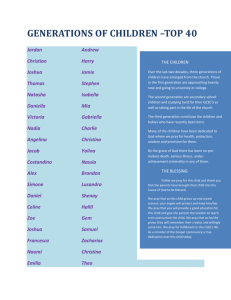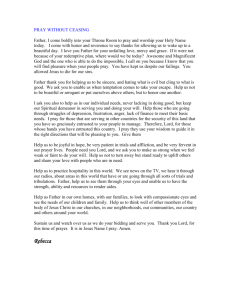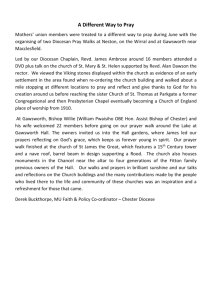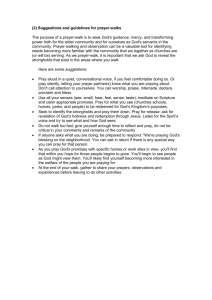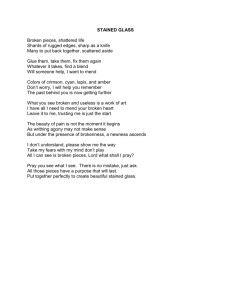Theron B. Pray The first president, 1894-1906
advertisement
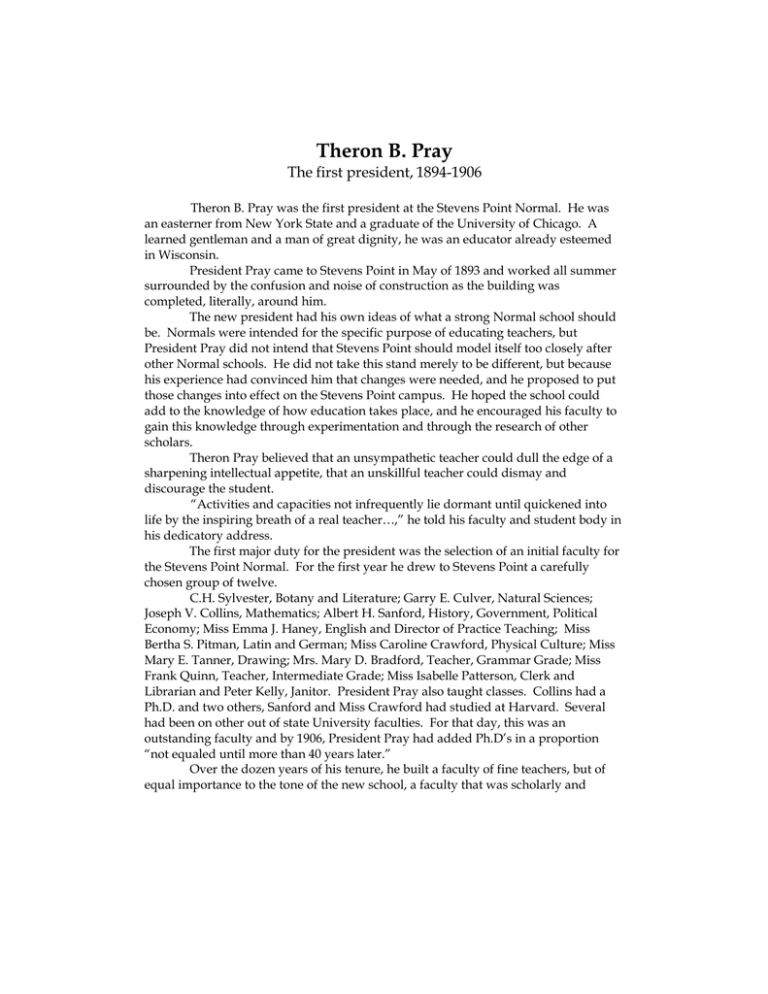
Theron B. Pray The first president, 1894-1906 Theron B. Pray was the first president at the Stevens Point Normal. He was an easterner from New York State and a graduate of the University of Chicago. A learned gentleman and a man of great dignity, he was an educator already esteemed in Wisconsin. President Pray came to Stevens Point in May of 1893 and worked all summer surrounded by the confusion and noise of construction as the building was completed, literally, around him. The new president had his own ideas of what a strong Normal school should be. Normals were intended for the specific purpose of educating teachers, but President Pray did not intend that Stevens Point should model itself too closely after other Normal schools. He did not take this stand merely to be different, but because his experience had convinced him that changes were needed, and he proposed to put those changes into effect on the Stevens Point campus. He hoped the school could add to the knowledge of how education takes place, and he encouraged his faculty to gain this knowledge through experimentation and through the research of other scholars. Theron Pray believed that an unsympathetic teacher could dull the edge of a sharpening intellectual appetite, that an unskillful teacher could dismay and discourage the student. “Activities and capacities not infrequently lie dormant until quickened into life by the inspiring breath of a real teacher…,” he told his faculty and student body in his dedicatory address. The first major duty for the president was the selection of an initial faculty for the Stevens Point Normal. For the first year he drew to Stevens Point a carefully chosen group of twelve. C.H. Sylvester, Botany and Literature; Garry E. Culver, Natural Sciences; Joseph V. Collins, Mathematics; Albert H. Sanford, History, Government, Political Economy; Miss Emma J. Haney, English and Director of Practice Teaching; Miss Bertha S. Pitman, Latin and German; Miss Caroline Crawford, Physical Culture; Miss Mary E. Tanner, Drawing; Mrs. Mary D. Bradford, Teacher, Grammar Grade; Miss Frank Quinn, Teacher, Intermediate Grade; Miss Isabelle Patterson, Clerk and Librarian and Peter Kelly, Janitor. President Pray also taught classes. Collins had a Ph.D. and two others, Sanford and Miss Crawford had studied at Harvard. Several had been on other out of state University faculties. For that day, this was an outstanding faculty and by 1906, President Pray had added Ph.D’s in a proportion “not equaled until more than 40 years later.” Over the dozen years of his tenure, he built a faculty of fine teachers, but of equal importance to the tone of the new school, a faculty that was scholarly and productive as well; for the character of a school is somewhat determined and shaped by those men and women who organize and run it first. Mary D. Bradford, a member of that first faculty, wrote years later that the school was considered to have a distinct individuality among schools of its kind. Widely recognized as Wisconsin’s outstanding woman educator of her day, Mrs. Bradford was proud to be chosen to serve with President Pray. When the doors opened on September 17, 1894, President Pray welcomed 201 students with a faculty-student ratio of 16 ¾. It is interesting to compare this with the ratio of 17 for the 1968-69 school year. Wisconsin Normal schools in 1893 tended to concentrate on preparing teachers in elementary education. Actually many of the students who came to SPN were experienced teachers who simply felt the need for more education. Students could enroll at any time and many studied for a short period, leaving when they secured a position to their liking. The complete course was for many years a two-year one. Life moved at a slower pace than it does today, and President Pray was pleased to show visitors through personally and to explain “Portage County’s pride” at anytime. “It would be best though not to come on Saturday, as that is the janitor’s busy day,” he informed the public. The Normal prospered and in 1901 it was necessary to add a wing at the west end of the building. The school’s reputation grew, and all seemed well until in 1906, the Regents asked Mr. Pray to submit his resignation. The request came without advance warning and with no stipulation of reasons for the request. It was a stunning blow to Mr. Pray and to many in the community and throughout the state papers carried accusations and counter accusations. The Board of Regents had taken its February 7 action in a closed executive session. President Pray received official notice of the Board’s action by letter on February 24. The Stevens Point Regent, C.D. Mc Farland, said later that the Board had expected Mr. Pray would spend the next several weeks seeking another position and then quietly submit his resignation to take effect in June as a voluntary one. Mr. Pray did not release the information, but the news got out. The Milwaukee Sentinal broke the story the morning of March 6. The student body protested and met without consulting the faculty in a unanimous expression of their loyalty to their president and their desire to stand behind him. Mrs. Bradford wrote later that Regent McFarland “had the temerity in a special faculty meeting, to attempt to intimidate us by a warning that any criticism of his action would not be permitted or tolerated. This preposterous treatment was resented generally by the faculty, but especially by those who had been there the longest.” Mrs. Bradford resigned in protest and was followed by all the critic teachers and several others, including President Pray’s daughter, Katherine, who taught Latin. When pressed, Mr. Farland submitted figures to substantiate his charge that a falling enrollment was the cause for Mr. Pray’s dismissal. The statistics were widely disputed, others were presented by President Pray’s old friend, former Regent, Byron B. Park; and a number of people stated in print that it was a case of personal ill feeling toward the president. Though Byron Park came to Pray’s defense, there appeared to have been some personal animosity between Mr. McFarland and Mr. Park, and it is difficult to get at the facts. President Pray is said to have asked that the charges against him be made public and that he be given a chance to meet and refute them if he could. However, a vacancy for the position was declared; he was presented with a typewritten statement of the general reasons for the Board’s resignation request. They read as follows: “First- the man who is now filling that position in not in the opinion of the Board, a vigorous and efficient administrative officer. “Second- He is not, in the opinion of the Board, an enthusiastic and inspiring teacher and educational leader. “Third- We believe these defects are temperamental, and that is, therefore, practically impossible for him to overcome them. “Fourth- We believe the Stevens Point Normal is not now securing the best results obtainable, all things considered.” When President Pray appeared before the Board, he did not refer to the charges made against him, but presented an objective appraisal of the situation at Stevens Point. He pointed out that the smaller enrollment was due to increased competition from the growing numbers of county training schools as well as the increasing demand on the part of high schools for teachers with university training. It was a situation that was to plague Stevens Point Normal and others of its kind in the state for many years, for these schools were in a sense caught in the middle of what many educators felt was an awkward and overlapping system of higher education in the state; a problem that was eventually solved as educational needs and population increased, when the schools were finally permitted to grant degrees. University status was as yet undreamed of. Probably the most outstanding graduate of those early years was the late Dr. Arnold Gessell, Class of 1899, famed child psychologist and Professor of Child Hygiene at Yale University. Margaret Ashmun, Class of 1897, became a popular author. Jesse H. Ames, Class of 1902, and Harvey A. Schofield, Class of 1901, were two who went on to become higher education presidents at River Falls and Eau Claire. Pray died in 1920 at age 71. ~*~

